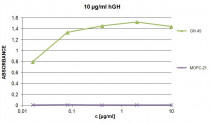ARG62995
anti-GH1 / Growth hormone antibody [GH-45]
anti-GH1 / Growth hormone antibody [GH-45] for ELISA,ICC/IF,IHC-Formalin-fixed paraffin-embedded sections and Human
Developmental Biology antibody; Signaling Transduction antibody
Overview
| Product Description | Mouse Monoclonal antibody [GH-45] recognizes GH1 / Growth hormone |
|---|---|
| Tested Reactivity | Hu |
| Tested Application | ELISA, ICC/IF, IHC-P |
| Specificity | The clone GH-45 reacts with human growth hormone (hGH), a polypeptide hormone synthesized by acidophilic or somatotropic cells of the anterior pituitary gland. The GH-45 antibody reacts with affinity constant 3.8 x 1010 l /mol; it does not bind human prolactin or any other pituitary hormones. |
| Host | Mouse |
| Clonality | Monoclonal |
| Clone | GH-45 |
| Isotype | IgG1 |
| Target Name | GH1 / Growth hormone |
| Antigen Species | Human |
| Immunogen | Human growth hormone. |
| Conjugation | Un-conjugated |
| Alternate Names | GH-N; Somatotropin; IGHD1B; Growth hormone; Growth hormone 1; Pituitary growth hormone; GHN; hGH-N; GH |
Application Instructions
| Application Suggestion |
|
||||||||
|---|---|---|---|---|---|---|---|---|---|
| Application Note | * The dilutions indicate recommended starting dilutions and the optimal dilutions or concentrations should be determined by the scientist. |
Properties
| Form | Liquid |
|---|---|
| Purification | Purified from ascites by protein-A affinity chromatography. |
| Purity | > 95% (by SDS-PAGE) |
| Buffer | PBS (pH 7.4) and 15 mM Sodium azide |
| Preservative | 15 mM Sodium azide |
| Concentration | 0.5 mg/ml |
| Storage Instruction | For continuous use, store undiluted antibody at 2-8°C for up to a week. For long-term storage, aliquot and store at -20°C or below. Storage in frost free freezers is not recommended. Avoid repeated freeze/thaw cycles. Suggest spin the vial prior to opening. The antibody solution should be gently mixed before use. |
| Note | For laboratory research only, not for drug, diagnostic or other use. |
Bioinformation
| Database Links | |
|---|---|
| Gene Symbol | GH1 |
| Gene Full Name | growth hormone 1 |
| Background | The protein encoded by this gene is a member of the somatotropin/prolactin family of hormones which play an important role in growth control. The gene, along with four other related genes, is located at the growth hormone locus on chromosome 17 where they are interspersed in the same transcriptional orientation; an arrangement which is thought to have evolved by a series of gene duplications. The five genes share a remarkably high degree of sequence identity. Alternative splicing generates additional isoforms of each of the five growth hormones, leading to further diversity and potential for specialization. This particular family member is expressed in the pituitary but not in placental tissue as is the case for the other four genes in the growth hormone locus. Mutations in or deletions of the gene lead to growth hormone deficiency and short stature. [provided by RefSeq, Jul 2008] |
| Function | Plays an important role in growth control. Its major role in stimulating body growth is to stimulate the liver and other tissues to secrete IGF-1. It stimulates both the differentiation and proliferation of myoblasts. It also stimulates amino acid uptake and protein synthesis in muscle and other tissues. [UniProt] |
| Research Area | Developmental Biology antibody; Signaling Transduction antibody |
| Calculated MW | 25 kDa |
Images (1) Click the Picture to Zoom In
-
ARG62995 anti-GH1 / Growth hormone antibody [GH-45] ELISA image
ELISA: Human growth hormone using ARG62995 anti-GH1 / Growth hormone antibody [GH-45]. Compared with ARG65323 Mouse IgG1 Kappa Isotype Control antibody [MOPC-21].








